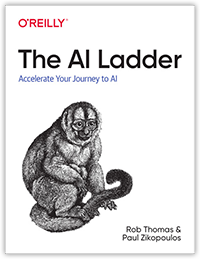1. AI and Data. Two newsletters in one.
The boundaries between data and AI are blurring. As the technologies have become more intertwined, so have the O'Reilly AI and Data Newsletters. So, as of the next issue, we're merging our Data and AI Newsletters, bringing together two of the most pressing technological trends of the decade into one concise, biweekly read. They'll arrive Mondays instead of Wednesdays, but you don't need to do a thing. We hope you like the change.
|
| |
2. Getting machine learning to production
Vicki Boykis offers a thorough look at how to move machine learning into production.
|
| |
3. Why artificial brains need sleep
Just like biological brains, "spiking" artificial neural networks may depend on slow-wave "sleep" for learning according to a recent study. The researchers ran computer simulations of a spiking neural network (which generates an output signal only after it receives a certain amount of input signals over a given time) and found that, although it could learn to identify the data it was trained to look for, when training went uninterrupted long enough its neurons began to continuously fire no matter what signals they received. "Almost in desperation," the researchers tried having the simulation essentially undergo deep sleep (by exposing it to cycles of oscillating noise, roughly corresponding to the slow brain waves seen in deep sleep), which restored the simulation to stability.
|
| |
4. 6 lessons learned to get ready for the next wave of COVID
After 100 days of working on COVID-19 issues, DJ Patil says, "Despite the already staggering costs of the COVID-19 pandemic—more than 100,000 American lives lost and a 19.7% unemployment rate—we still are in the early stages of addressing the COVID-19 pandemic. While we have 'flattened the curve' through aggressive measures of physical distancing, the longer-term social, mental, and chronic health impacts are far from being understood and may take years to appreciate." Here, he outlines key structural cracks in our defense against disease outbreaks and offers advice on how to prepare for the next surge.
+ "NIH Launches Massive Initiative for COVID-19 Patient Data Analytics."
|
| |
5. An intro to causal flows
Most, if not all, business analytics questions are inquiries of cause and effect. Discerning associative relationships from causal relationships is crucial to answering those questions accurately. Here's an intro.
|
| |
| |
|
IN COLLABORATION WITH IBM
Free: The AI Ladder—Accelerate Your Journey to AI

AI may be the greatest opportunity of our time, with the potential to add nearly $16 trillion to the global economy over the next decade. But so far adoption has been much slower than anticipated. With this practical guide, business leaders will discover where they are in their AI journey and learn the steps necessary to successfully scale AI throughout their organization. And it's free, courtesy of IBM.
|
| |
| |
6. Collider bias
FiveThirtyEight looks at why statistics don’t capture the full extent of the systemic bias in policing.
|
| |
7. What Eugene Yan loves about Scrum for data science
He was made to adopt Scrum in his work. He didn't like it. But it grew on him. Here's why.
|
| |
8. 10 Python tricks
Here are some useful tips using the standard library and packages usually associated with scientific computing in Python.
|
| |
| |
| |
|
|
| |
|
Read our Privacy Policy.
O’Reilly Media, Inc. 1005 Gravenstein Highway North, Sebastopol, CA 95472 (707) 827-7000
|
|
|